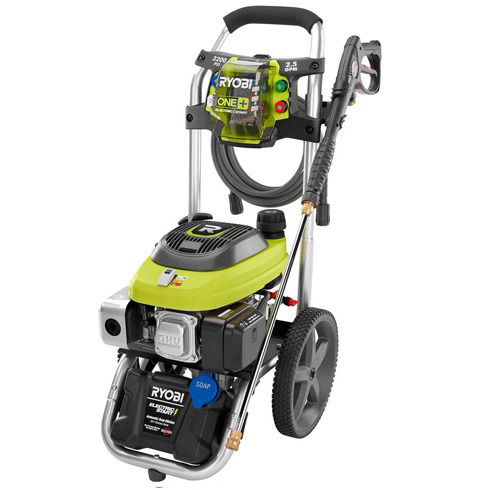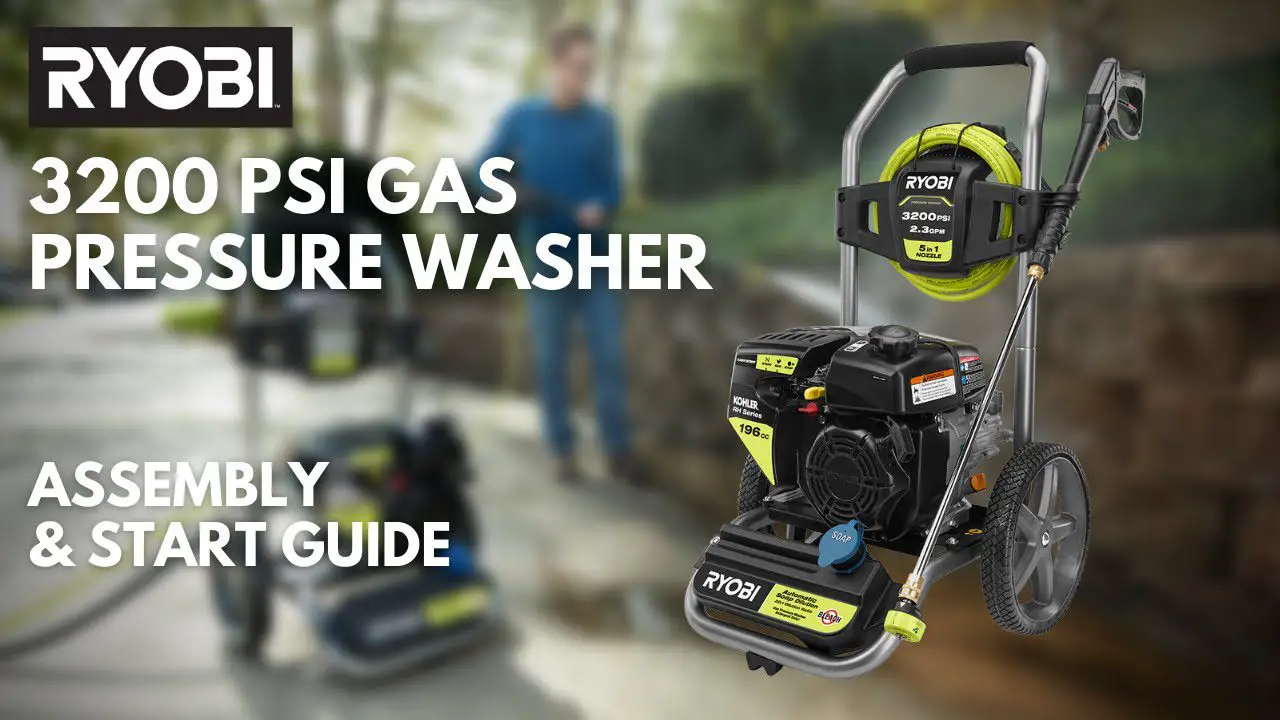Unlocking the power of a Ryobi pressure washer can transform your cleaning routine, making it both efficient and enjoyable. Whether you’re tackling grimy driveways, mildew-covered decks, or muddy garden tools, this tool is your ultimate ally.
But where do you start? The process might seem daunting at first, especially if you’re not familiar with pressure washers. Don’t worry; we’ve got you covered. This guide is designed with you in mind, ensuring you feel confident and ready to tackle any cleaning task.
By the end of this post, you’ll not only know how to start your Ryobi pressure washer effortlessly, but you’ll also discover tips and tricks to maximize its performance. Ready to make your cleaning tasks quicker and more effective? Let’s dive in!

Credit: www.youtube.com
Contents
Choosing The Right Ryobi Pressure Washer
Choosing the right Ryobi pressure washer is crucial for your cleaning needs. Whether you want to wash your car or clean your patio, selecting the right model makes all the difference. Ryobi offers various pressure washers with different features. Understanding these options helps you make an informed choice.
Electric Vs. Gas Models
Electric models are quieter and lightweight. They are perfect for small tasks around the house. Plug them into a standard outlet and start cleaning. Gas models are powerful and suitable for heavy-duty tasks. They provide more pressure for stubborn dirt. Gas models are portable, making them ideal for outdoor use.
Key Features To Consider
Consider the pressure level first. High pressure removes dirt faster. Check the flow rate for efficiency. More water flow cleans larger areas quicker. Look for adjustable nozzles for different tasks. They allow you to change the spray pattern as needed. Hose length is important for reach. Longer hoses cover more ground without moving the machine.
Preparing For Use
Before starting your Ryobi pressure washer, preparation is key. Proper preparation ensures efficient use and extends your washer’s life. This guide will help you get started smoothly and confidently.
Gathering Necessary Tools And Accessories
First, collect all essential tools and accessories. You’ll need a garden hose, a power cord, and a water source. Ensure the hose fits snugly with the washer. This prevents leaks and ensures smooth operation.
Locate the spray nozzle and any other attachments. Keep them within reach for easy access. These components are crucial for different cleaning tasks.
Inspecting The Washer Components
Inspect your Ryobi pressure washer carefully. Check the power cord for any visible damage. Damaged cords can be hazardous.
Examine the spray gun and nozzle for signs of wear. Ensure all connections are tight and secure. Loose parts can lead to inefficiency.
Inspect the water inlet filter. Clean it if necessary to prevent blockages. A clean filter ensures consistent water flow.
Check the oil level in your washer. If it’s low, fill it to the recommended level. Adequate oil is vital for engine performance.
By following these steps, your Ryobi pressure washer will be ready for use. Proper preparation leads to better results and a longer lifespan for your equipment.
Setting Up The Pressure Washer
Starting a Ryobi Pressure Washer involves connecting the hose and spray gun. Ensure water supply is securely attached. Turn on the power, then press the trigger for cleaning action.
Setting up your Ryobi pressure washer is straightforward. This powerful tool helps clean surfaces efficiently. Follow these steps to ensure a smooth setup. Proper preparation enhances performance and longevity.Connecting The Hose
Begin by connecting the garden hose. Attach it to the water inlet on the pressure washer. Ensure the connection is tight. This prevents leaks during operation. Use a standard garden hose for compatibility. Check for kinks or bends in the hose. Straighten it to allow proper water flow.Attaching The Spray Gun
Next, attach the spray gun to the wand. Align the spray gun with the wand’s connector. Twist the spray gun clockwise to secure it. Ensure the connection is firm. This helps maintain pressure during use. The spray gun allows controlled water flow. Test the connection by gently pulling it.Installing The Nozzle
Choose the appropriate nozzle for your task. Each nozzle offers different pressure and spray patterns. Push the nozzle into the spray gun’s tip. Ensure it clicks into place. This prevents it from detaching during use. Test the nozzle by spraying briefly. Adjust to the desired spray pattern.Filling And Checking Fluids
Check all fluids before starting your Ryobi pressure washer. Ensure oil and fuel levels are adequate. This simple step guarantees smooth operation and prolongs the machine’s lifespan.
Getting your Ryobi pressure washer ready for action involves more than just hitting the start button. Filling and checking fluids is a crucial step that ensures your machine operates smoothly and efficiently. Whether you’re dealing with a gas model or an electric one, paying attention to the fluids can make the difference between a successful cleaning session and a frustrating ordeal. Let’s dive into the essentials of fueling, oil checks, and water connections.Fueling A Gas Model
Using a gas-powered Ryobi pressure washer? Start by ensuring the gas tank is filled with fresh unleaded fuel. Always use gasoline with an octane rating of 87 or higher. Avoid adding fuel additives as they can sometimes cause more harm than good. Make sure to fill the tank in a well-ventilated area. This prevents the buildup of harmful fumes. Double-check that the gas cap is securely fastened before moving on.Checking Oil Levels
Before you fire up your pressure washer, checking the oil level is a must. Locate the oil cap and dipstick, usually found near the engine. Unscrew the cap, wipe the dipstick clean, and then reinsert it to get an accurate reading. If the oil level is low, top it up with the recommended oil type specified in your user manual. Too little oil can cause engine damage, while too much can lead to leaks. Always aim for that perfect balance.Connecting To Water Supply
Connecting your pressure washer to a water source might seem straightforward, but it’s easy to overlook the basics. Attach the garden hose securely to the water inlet on the pressure washer. Ensure there are no kinks or leaks in the hose that could restrict water flow. Turn on the water supply fully before starting the machine. This prevents air from entering the pump, which can cause damage. A steady water supply is key to maintaining consistent pressure during use. Ever been caught off guard by water spraying everywhere due to a loose connection? It’s a common mishap that can be easily avoided with a quick double-check. Paying attention to these details ensures your Ryobi pressure washer is ready to tackle any cleaning challenge you throw its way.Starting The Ryobi Pressure Washer
Starting a Ryobi pressure washer is simple. First, connect the garden hose and turn on the water. Next, switch the power to ‘on’, then squeeze the trigger to release pressure and begin cleaning.
Starting your Ryobi pressure washer can seem daunting at first. But with clear steps, it becomes simple. Whether you have an electric or gas model, knowing the right process is key. This guide will help you start your Ryobi pressure washer.Steps For Electric Models
Starting an electric Ryobi pressure washer is straightforward. First, ensure the power switch is off. Connect the garden hose to the inlet. Attach the high-pressure hose to the outlet. Plug the power cord into a grounded outlet. Turn the water supply on fully. Squeeze the trigger to release air from the system. Now, turn the switch to the ‘on’ position. Your electric pressure washer is ready.Steps For Gas Models
Gas models require a few more steps. First, check the oil and fuel levels. Ensure the fuel valve is open. Connect the garden hose to the inlet. Attach the high-pressure hose to the outlet. Turn the water supply on fully. Move the choke to the ‘closed’ position. Ensure the throttle is set to ‘fast’. Pull the starter cord firmly. Once the engine starts, move the choke to ‘open’. Your gas-powered pressure washer is ready.
Credit: espanol.ryobitools.com
Operating Safely
Operating a Ryobi pressure washer safely is crucial for effective cleaning. Ensuring safety not only protects you but also prolongs the machine’s life. Understanding the right procedures and precautions is essential.
Adjusting Pressure Settings
Start with the lowest pressure setting. This prevents damage to surfaces. Gradually increase as needed. Test on a small area first. Different surfaces need different pressures. Wood requires less pressure than concrete.
Safety Precautions During Use
Wear protective gear. Gloves and goggles are recommended. Keep children and pets away. Ensure the area is clear of obstacles. Stay aware of your surroundings. Avoid pointing the nozzle at people. Never use it without proper footwear. Water pressure can cause injury.
Troubleshooting Common Issues
Starting a Ryobi pressure washer involves checking the fuel level and ensuring the power switch is on. Turn the choke lever to the “start” position, and pull the starter cord firmly. If it doesn’t start, inspect the spark plug and air filter for dirt.
Dealing with a Ryobi pressure washer that’s not functioning as expected can be frustrating. However, before you decide to call in professional help, there are a few common issues you can troubleshoot yourself. Understanding these challenges not only saves you time but also ensures your machine runs efficiently. Let’s dive into some typical problems and how you can address them effectively.Low Pressure Problems
Low pressure can turn a powerful cleaning tool into a frustrating experience. Often, this issue stems from a clogged nozzle. A quick fix? Simply detach the nozzle and clear any debris with a small wire or pin. Another culprit could be a dirty water filter. Regularly cleaning or replacing the filter can make a huge difference. Have you checked the hose? Sometimes, kinks or leaks can reduce pressure too.Engine Starting Troubles
Is your pressure washer refusing to start? Start by ensuring there’s enough fuel in the tank. It sounds basic, but it’s a common oversight. If the fuel is fine, inspect the spark plug. A worn-out spark plug can be the reason your engine won’t start. Replacing it could solve your problem. Have you tried adjusting the choke? Sometimes a simple adjustment can get the engine purring again.Water Leakage Concerns
Noticing water where it shouldn’t be? Leaks are often due to loose connections. Tighten any loose hose connections or fittings with a wrench. Inspect the O-rings and seals. These small parts wear out over time and may need replacing. Lastly, check for any visible cracks in the hose. Replacing a damaged hose is crucial to prevent leaks. These quick checks and fixes can often solve common issues with your Ryobi pressure washer. Have you tried these solutions, or do you have other tips to share? Your experiences could help others too!
Credit: espanol.ryobitools.com
Maintaining Your Pressure Washer
Starting a Ryobi pressure washer involves a few simple steps. First, connect the water supply to the washer. Next, ensure the fuel tank is full and the spark plug is connected. Finally, pull the starter cord gently to start the engine.
Regular maintenance ensures efficient performance.
Maintaining your Ryobi pressure washer ensures it lasts longer and performs efficiently every time you use it. You might not think about maintenance until something goes wrong. But a little care can prevent many issues and save you time and money. Imagine you’re ready to start a big cleaning job, and suddenly the pressure washer won’t start. Avoid this hassle by taking simple maintenance steps. Let’s dive into some practical tips to keep your pressure washer in top shape.Regular Cleaning Tips
Regular cleaning of your pressure washer is crucial to its longevity. After each use, clean the nozzle to prevent clogs. A clogged nozzle can reduce water pressure and affect performance. Inspect the spray gun and hose for any debris. Wipe them down with a damp cloth. Clean the air filter every few months to ensure optimal airflow, especially if you’ve used the washer frequently.Storage Recommendations
Proper storage can significantly extend the life of your Ryobi pressure washer. Always store it in a dry, sheltered place to prevent rust and damage from the elements. If you’re storing it for the winter, drain all the water from the pump and hoses to avoid freezing and cracking. Consider using a pump saver antifreeze solution. This protects the internal components during long periods of inactivity. Before you tuck it away, cover it with a protective cover to keep dust and dirt at bay. Have you ever pulled out a dusty tool only to find it doesn’t work anymore? Don’t let that be your pressure washer. Take a few minutes to store it right, and you’ll thank yourself later.Frequently Asked Questions
How Do I Start A Ryobi Pressure Washer?
To start a Ryobi pressure washer, first connect the water supply. Turn on the water and squeeze the trigger to release air. Then, switch the fuel valve to “On” for gas models. Finally, pull the starter cord firmly or press the start button for electric models.
Why Won’t My Ryobi Pressure Washer Start?
If your Ryobi pressure washer won’t start, check the fuel level and spark plug for gas models. Ensure the power source is connected for electric models. Also, inspect the water supply and hose for any blockages. Regular maintenance helps prevent starting issues.
How Do I Maintain My Ryobi Pressure Washer?
Regular maintenance of your Ryobi pressure washer includes checking oil levels and cleaning air filters. Inspect hoses and connections for leaks. Run fresh water through the system after use to prevent clogs. Store the washer in a dry place to avoid rust and damage.
What Fuel Does A Ryobi Pressure Washer Use?
Ryobi gas-powered pressure washers typically use unleaded gasoline with an octane rating of 87 or higher. Do not use gasoline with more than 10% ethanol. Always check your model’s manual for specific fuel requirements and follow safety guidelines when refueling the machine.
Conclusion
Starting a Ryobi pressure washer is simple with these steps. First, gather all necessary equipment. Next, ensure the water supply is connected. Then, check the fuel and oil levels. Turn on the machine using the power switch. Adjust settings for desired pressure.
Finally, begin your cleaning task. Regular maintenance ensures long-lasting performance. Follow these tips for smooth operation every time. Enjoy efficient cleaning without hassle. With practice, tasks become easier. Keep safety in mind throughout. Your Ryobi pressure washer will deliver excellent results with proper care.

